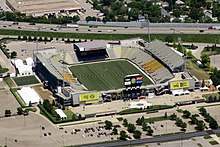
A | B | C | D | E | F | G | H | CH | I | J | K | L | M | N | O | P | Q | R | S | T | U | V | W | X | Y | Z | 0 | 1 | 2 | 3 | 4 | 5 | 6 | 7 | 8 | 9

Soccer-specific stadium is a term used mainly in the United States and Canada[1] to refer to a sports stadium either purpose-built or fundamentally redesigned for soccer and whose primary function is to host soccer matches, as opposed to a multi-purpose stadium which is for a variety of sports. A soccer-specific stadium may host other sporting events (such as lacrosse, American football and rugby) and concerts, but the design and purpose of a soccer-specific stadium is primarily for soccer. Some facilities (for example SeatGeek Stadium, Toyota Stadium and Historic Crew Stadium) have a permanent stage at one end of the stadium used for staging concerts.
A soccer-specific stadium typically has amenities, dimensions and scale suitable for soccer in North America, including a scoreboard, video screen, luxury suites and possibly a roof. The field dimensions are within the range found optimal by FIFA: 110–120 yards (100–110 m) long by 70–80 yards (64–75 m) wide.[2] These soccer field dimensions are wider than the regulation American football field width of 53+1⁄3 yards (48.8 m), or the 65-yard (59 m) width of a Canadian football field. The playing surface typically consists of grass as opposed to artificial turf, as the latter is generally disfavored for soccer matches since players are more susceptible to injuries.[3] However, some soccer specific stadiums, such as Portland's Providence Park and Creighton University's Morrison Stadium, do have artificial turf.
The seating capacity is generally between 18,000 and 30,000 for a Major League Soccer franchise,[4] or smaller for college or minor league soccer teams. This is in comparison to the much larger American football stadiums that mostly range between 60,000 and 80,000 in which the original North American Soccer League teams played and most MLS teams occupied during the league's inception.[5] As opposed to gridiron-style football stadiums, where the front row of seats is elevated several feet above the field of play to allow spectators to see over the heads of substitute players and coaches on the sidelines, soccer-specific venues typically have the front row closer to the level of the pitch.[6][7]
History

In the 1970s, 80s and 90s, first-division professional soccer leagues in the United States, such as the North American Soccer League and Major League Soccer, primarily used American football fields, many of which were oversized in terms of seating capacity and undersized in terms of the width of the soccer field; they often used artificial turf (none of which, at the time, were approved for international soccer under FIFA rules).[citation needed] Although many of the baseball parks had smaller capacities, natural grass, and a wider field, these parks were generally in use during summer, when North American–based soccer leagues, such as Major League Soccer, also hold their seasons, and the irregular field dimensions and sightlines were often considered undesirable.
Soccer-specific stadiums first came into use in the 1990s, after the multi-purpose stadium era.[8][9]
The term "soccer-specific stadium" was coined by Lamar Hunt, who financed the construction of the Columbus Crew Stadium, the first soccer-specific stadium constructed specifically for Major League Soccer.[8] In the 2000s, other Major League Soccer teams in the United States began constructing their own stadiums. Canada's first soccer-specific stadium was BMO Field in Toronto, home to Toronto FC. This stadium was renovated to accommodate Canadian football for the 2016 and subsequent seasons.[10] The distinction is less prominent in Canada, where MLS's attendance figures are comparable to those of the domestic Canadian Football League, and the CFL's wider field means fewer compromises must be made to accommodate both; Tim Hortons Field was built purposely to both soccer specifications and CFL regulations. Of the three Canadian cities that host both MLS and CFL teams, only one (Montreal) has separate stadiums for each.
Major League Soccer (MLS)
Current MLS soccer-specific stadiums
Under construction
| Stadium | Club(s) | City | Proposed capacity | Potential opening date |
|---|---|---|---|---|
| Miami Freedom Park | Inter Miami CF | Miami, Florida | 25,000 | 2025 |
| New York City FC stadium | New York City FC | Queens, New York | 25,000 | 2027 |
National Women's Soccer League (NWSL)
Current NWSL soccer-specific stadiums
| Stadium | Club(s) | City | Capacity | Opened |
|---|---|---|---|---|
| Audi Field | Washington Spirit | Washington, D.C. | 20,000 | 2018 |
| BMO Stadium | Angel City FC | Los Angeles, California | 22,000 | 2018 |
| CPKC Stadium | Kansas City Current | Kansas City, Missouri | 11,500 | 2024 |
| Exploria Stadium | Orlando Pride | Orlando, Florida | 25,500 | 2017 |
| Lynn Family Stadium | Racing Louisville FC | Louisville, Kentucky | 11,700 | 2021 |
| Shell Energy Stadium | Houston Dash | Houston, Texas | 22,039 | 2012 |
| Providence Park | Portland Thorns FC | Portland, Oregon | 25,218 | 2011 |
| Red Bull Arena | NJ/NY Gotham FC | Harrison, New Jersey | 25,000 | 2010 |
| SeatGeek Stadium | Chicago Red Stars | Bridgeview, Illinois | 20,000 | 2006 |
| WakeMed Soccer Park | North Carolina Courage | Cary, North Carolina | 10,000 | 2002 |
United Soccer League (USL)
Current USLC and USL1 soccer-specific stadiums
All USL Championship teams and USL League One teams will be required to play in self-owned, soccer-specific stadiums by the 2022 season. The following is a list of current USL stadiums that are soccer-specific stadiums:
